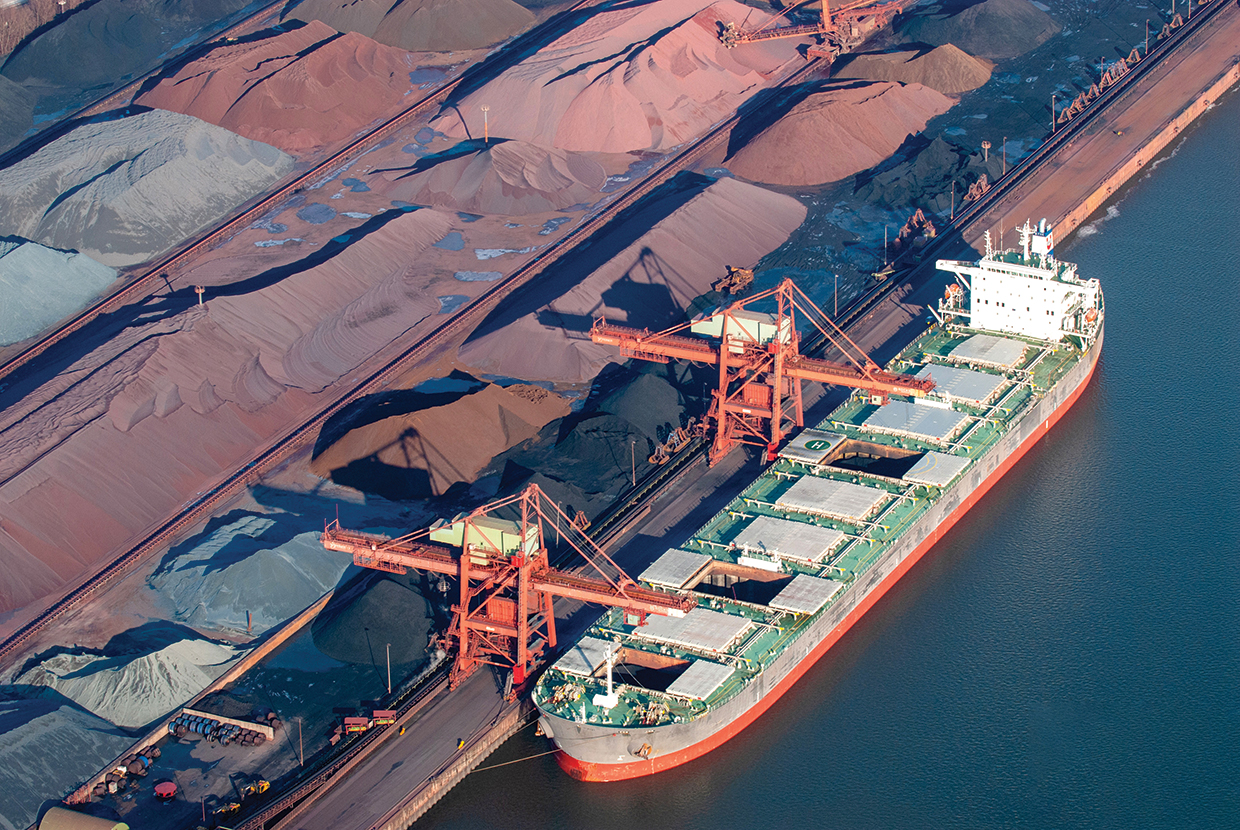The commodity trading sector is no stranger to inefficiency, fraud and financing turmoil. Proponents of electronic bills of lading have long insisted they provide solutions to all of these issues, yet despite regulatory reforms and promising signs in the metals market, commodity financing remains largely paper-based. John Basquill reports.
Back in 1999, in the early days of the World Wide Web, technology magazine Wired published an article hailing the transformative potential of digitising trade documents.
Industry participants said that turning to electronic bills of lading (eBLs) – the digital version of one of trade’s most vital components, acting as both title to goods and a trigger for payment – promised savings of millions of dollars and a change in the nature of trade disputes.
A “storm” of paper would make way for the efficient and secure transfer of title documents, Wired said. Bolero, which still exists as an eBL provider today but was in its infancy at the time of publication, had the “buzz of the internet around it”.
More than 25 years on, the eBL has yet to take hold across much of the trade world. Adoption is generally low, with progress largely isolated to pockets within the industry and limited to particular regions or routes.
Increasingly, there are promising signs within the commodity trading sector, with major companies completing landmark projects and clinching financing facilities linked to electronic bills. Regulatory barriers are being chipped away in major trading jurisdictions, and several initiatives are underway to create interoperability between competing eBL platforms.
But in an ecosystem involving lenders, traders, shipping companies, customs authorities and numerous other parties – and where old habits die hard – the shift away from paper is still in need of a push.
Patchy adoption
Many of the immediate benefits of converting from paper to electronic bills are the same today as in 1999: cost savings, greater efficiency and better traceability.
A 2022 paper by McKinsey estimated that moving to eBLs would cut direct trade costs by as much as US$6.5bn per year. Yet in containerised trade, the Digital Container Shipping Association says fewer than 5% of bills of lading were issued digitally last year.
A survey of around 300 industry representatives carried out last year by the Future of International Trade Alliance, which brings together three major industry groups as well as Swift and the International Chamber of Commerce (ICC), found companies involved in trade appear open to digitising.
Around 42% of firms reported using a combination of paper and electronic bills, up from 28% two years earlier. Three-quarters of those still using paper exclusively said they had plans in place to transition to eBLs.
Lenders appear to be lagging, however. Just 21% of bank respondents said their institution had already adopted eBLs, and only 28% planned to do so within the following two years. The Alliance said the survey highlighted “structural and regulatory concerns within the financial sector” that are continuing to act as a block to digitalisation.
That may seem surprising. Trade hubs Singapore and the UK each enacted legislation giving electronic bills the same legal standing as their paper equivalents, in 2021 and 2023 respectively.
Those laws were drafted in line with the Model Law on Electronic Transferable Records (MLETR), which was finalised by a UN body in 2017 and has served as a starting point for reforms in numerous jurisdictions. But only a handful of countries have such laws in place today.
“Logistically, even if you might have the content of a bill of lading being transferred electronically, there’s still a problem if the goods are being transported to a market where customs authorities aren’t going to go with it,” says Singapore-based lawyer Baldev Bhinder, managing partner at Blackstone & Gold.
“Even if the entry point of the system is electronic, you still need someone at the exit point of the trade that will accept it. It defeats the purpose if you end up with a hybrid system, where it can be digital in some parts but has to be physical in others.”
And in the UK’s case, there are still uncertainties over the legislation itself, says Jacqueline Bell, a partner at Dentons specialising in trade commodity finance and shipping, and co-head of the firm’s Europe transportation and infrastructure sector.
“Looking from a legal perspective, we think there are a few vulnerabilities where the wording of the legislation could be tested,” she tells GTR.
For instance, the UK law only recognises an eBL as valid if a “reliable system” is used to identify, protect and transfer it. Though it sets out seven criteria for what constitutes “reliable”, the wording is technologically neutral to avoid being overly prescriptive.
“This is an extreme example, but what if there were a nefarious attack on one of these platforms, intended to disrupt trade, which disabled one platform but which another could withstand?” Bell says.
“If a court then found that the first platform was not a reliable system, then did you ever have an eBL? Could you actually rely on it? It is crucial to have document fallbacks for the scenario that the eBL ultimately does not meet the legislative requirements of an eBL.”
Cross-industry efforts are underway to address some of these issues. The ICC’s Digital Standards Initiative and Canada’s Digital Governance Council launched a tool in October 2024 enabling eBL platform providers to submit a self assessment of their systems for review. The following month, Swedish fintech Enigio became the first provider to be recognised as a “reliable system”.
But highly regulated organisations such as financial institutions are likely to remain cautious until issues are tested in court.
Digitalising metals flows
One area of commodities trading where eBL usage is growing rapidly is the metals and mining sector.
In 2023, members of the Metals and Mining Digitalisation Forum – a working group set up by Anglo American, BHP, Rio Tinto and Vale – announced their participation in the “25 by 25” campaign, established by the Baltic and International Maritime Council (Bimco).
The quartet pledged to use eBLs for 25% of annual seaborne trade volumes for at least one commodity by 2025. By July 2024, this target had already been surpassed, with members announcing their average adoption rate for iron ore trade had hit 25.1%.
Bimco said at the time it was “thrilled to see such rapid progress, which highlights the dedication of key players in the dry bulk sector to improving operational efficiency through digital solutions”, and that the campaign would now be broadened to cover other bulk trades.
Forum documentation seen by GTR shows mining companies’ clients praising improvements in efficiency in the “last mile” of transactions, with buyers able to expedite clearing processes. Companies also note that using eBLs mitigates the risk of losing original documents as they are transferred between parties.
Shobhit Singh, Trafigura’s head of trade finance for metals, minerals and bulk commodities, suggests the way the metals market functions makes it particularly well suited for digitalisation.
“When you have to deliver the cargo to the counterparty, in most cases you need to produce the electronic or paper bill of lading to get customs clearance,” he tells GTR.
“The whole settlement will be dependent on the actual bill of lading, and that means the eBL is highly appreciated, because it speeds up all the processes related to that.
“Imagine I’m sending cargoes from Latin America to China, and I must wait for the original bills of lading to arrive to settle the transaction. We have had live cases where normally that would take 30 days, but when we utilise eBLs we can reduce that time by half. It’s a substantial benefit from an efficiency and cost perspective.”
Trafigura has also made strides in integrating eBLs into its financing arrangements. In October last year, the trading giant renewed a US$2.88bn borrowing base for its concentrates business, drawing support from a syndicate of 27 commodity finance lenders, including facility and security agent ING.
Under the facility, Trafigura is now able to use eBLs as secured collateral, giving banks a lien on the cargoes being shipped. In metals, Singh says the deal shows eBL are “gaining a lot of traction, which is good to see”.
Oil, risk and LOIs
The oil trading market has so far shown little appetite for eBLs. Singh points out that in oil, trading chains can often be much longer than in metals, with several trading companies participating in a single shipment.
Another “massive difference” is the oil market’s widespread use of letters of indemnity (LOIs), which can mean original bills of lading are not needed to clear customs and deliver the cargoes to the end customer, he says.
LOIs are used to allow cargo to be discharged and funds released before delivery of the original bill of lading. They typically work as a promise from the receiver of goods to locate and surrender the original documentation if required.
The risk with LOIs – as highlighted by a string of court cases in recent years – is if there is fraud connected to the underlying trade, such as duplicate financing.
“A trader is making these promises, but they’re not the one who shipped the goods as an intermediate trader,” Bhinder tells GTR. “They might find that across the whole chain it’s the blind leading the blind, and they might end up being the one left holding the baby.
“In that situation, they might be open to being accused of making false representations in their documentation if the cargo has not actually been shipped or has been double booked.”
Recent high-profile cases have involved trade finance lenders being stung when using LOIs. In 2023, a Singapore appeals court ruled that UniCredit was not entitled to claw back a US$37.2mn loss it suffered due to fraud committed by Hin Leong, following the trading house’s infamous collapse in 2020.
UniCredit had issued a letter of credit to Hin Leong for the sale of oil to Glencore, part of a circular transaction where Hin Leong would repurchase the same cargo. The bank disbursed the funds to Glencore on the basis of an LOI, but Hin Leong fell into financial difficulties and failed to pay Glencore.
UniCredit argued Glencore had made false representations when it provided that LOI, but the court ruled that the LOI did not contain representations – false or otherwise – and the bank “accepted the risk that came with such a payment”.
The Hin Leong collapse, along with other fraud scandals that engulfed the commodities sector during 2020 and 2021, would seemingly make a strong case for eBLs. Rather than rely on LOIs, bills could be delivered instantly from party to party, and therefore arrive in time for the discharge of cargo.
“I expected that after the disaster of Hin Leong, there would definitely be something better than working with an LOI,” one trade industry insider says, speaking on condition of anonymity. “I’m actually very surprised this has not been brought to the next level.”
Bhinder adds: “You might have thought after Hin Leong happened, and lots of banks were exposed, this concept of a one-page LOI might have gone out of fashion.
“But no, it didn’t, it’s still very much alive. I think that goes to show how hard it is to change human behaviour, even once everyone’s seen some of the risks with LOIs.”
Financing incentives
Despite slow progress in the oil market, some industry insiders believe the eBL’s capacity for fraud prevention could become a significant boost for smaller and mid-market commodity traders.
In the wake of those scandals, many lenders retreated from the commodity finance market or concentrated their focus on larger, established players. Today, trading giants regularly clinch mammoth working capital facilities from large bank syndicates while their smaller rivals struggle to access transactional trade finance.
Alex Waites, executive director at Enigio, says mid-sized traders are increasingly turning to digitalisation to demonstrate integrity and control over their documentation, and in doing so “shift long-standing perceptions around trade finance risk”.
“In conversations with traders, we find that operational efficiency is often the initial hook: avoiding courier delays, cutting costs and reducing administrative friction,” he tells GTR.
“But what resonates most – particularly with finance and compliance teams – is the ability to prevent fraud through documents that are digitally original, tamper-proof and fully traceable.”
As a result, traders are “not only streamlining operations but also unlocking new financing opportunities”, he says.
Waites adds he has seen a “noticeable uptick in interest” within the commodities sector over the last 12 to 18 months.
“What’s changing now is that mid-market traders, especially those feeling the pressure of margin compression, tighter financing and increased documentation scrutiny, are showing real appetite,” he says.
“Among these, soft commodities and agri-traders appear more proactive, likely due to the time-sensitive nature of shipments and frequent use of short-term financing tools.”
Wider uptake could also prove lucrative for the banks themselves, Dentons’ Bell suggests. Currently, she says the majority of banks tend to pay a lower advance rate – the percentage of a shipment’s value they’re willing to lend upfront, based on the document presented – if a bill of lading is in any form other than an original endorsed bill of lading.
“Holding an original bill of lading is the best you can get. In that scenario, a bank may lend, say, 85% of the value of the bill of lading,” she says.
“If it’s a copy bill of lading, it will be a lower percentage because there’s a bit more risk. It might be that the banks that accept financing eBLs first end up getting more business, because it will open up greater lines of financing for traders.”
Should banks be doing more to push for adoption of eBLs?
“They’re the ones that suffer fraud losses, and if they tell their customers they will only use eBLs then that will be the way people go,” Bhinder says.
“But banks tend to be customer-centric and try to help their customers however they want to do business. If banks said they were more comfortable lending or giving larger lines because it’s eBLs, I think that would work better for the system.”








